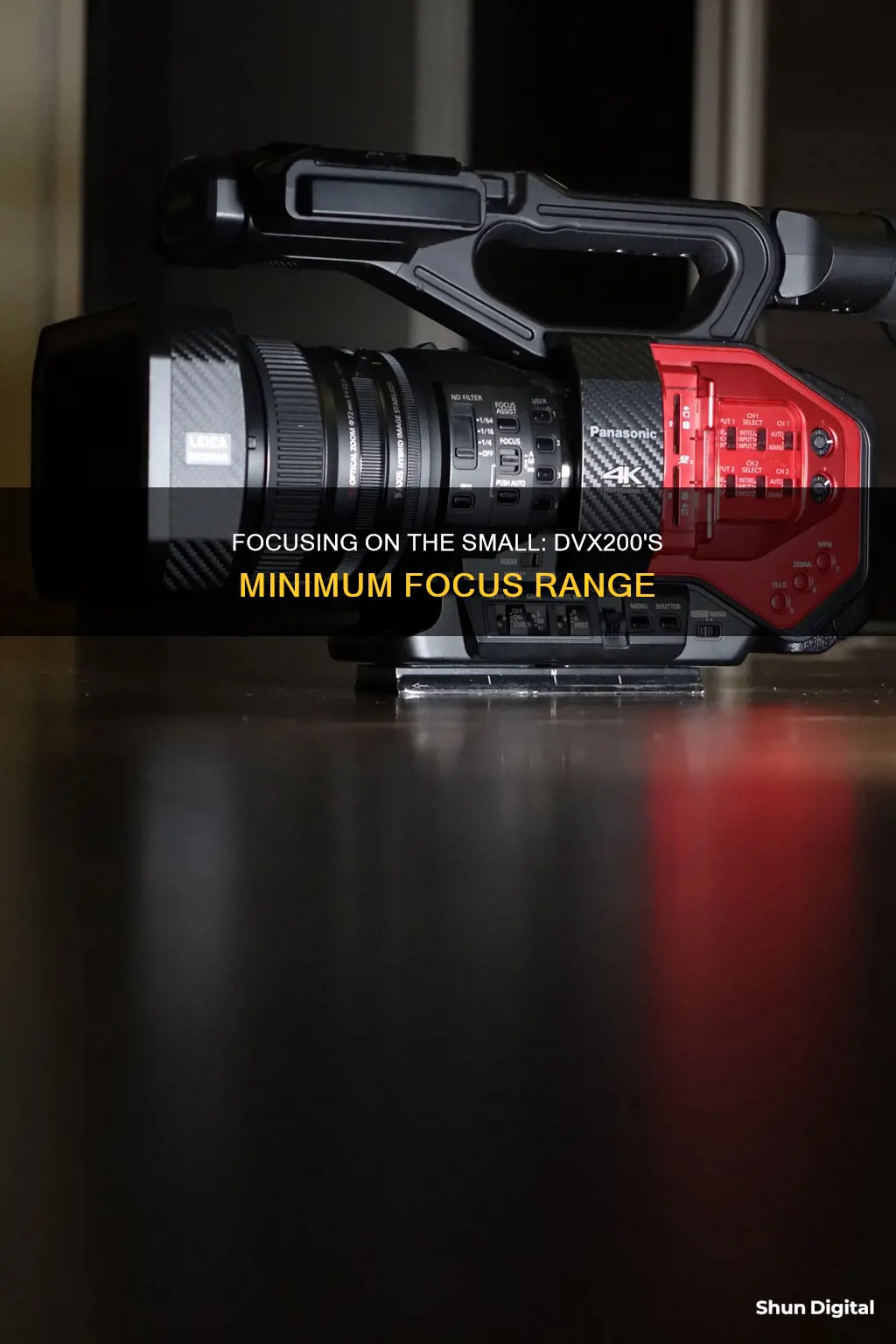
The Panasonic AG-DVX200 is a 4K large-sensor, 4/3 handheld camcorder with a fixed zoom lens. It has a minimum focus distance of approximately 1 metre (3.28 ft) from the foremost lens. However, this distance can be shortened to approximately 10 cm (0.33 ft) by using the FOCUS MACRO function. The camera offers a range of features such as a shallow depth of field, a wide field of view, and easy focus and zooming capabilities. With its integrated lens design and optimal weight balance, the DVX200 is well-suited for independent film, documentary production, and event videography.
| Characteristics | Values |
|---|---|
| Minimum Object Distance (MOD) | 1m (3.28ft) from the foremost lens |
| Minimum Object Distance (MOD) with Macro function | 10cm (0.33ft) at the wide-angle end |
What You'll Learn
- The DVX200's minimum focus distance is 1m, but this can be shortened to 10cm with the Macro function
- The camera has three focus modes: Speed, Coarse, and Fine
- The lens has a focal length of 12.8mm to 167mm
- The lens has a variable aperture of F2.8 to F4.5
- The DVX200 has a focus transition feature, allowing the focus point to shift between two or three pre-registered positions

The DVX200's minimum focus distance is 1m, but this can be shortened to 10cm with the Macro function
The Panasonic DVX200 is a 4K camera with a fixed lens. It has a minimum focus distance of 1 metre, but this can be shortened to 10 centimetres with the Macro function. This is a useful feature for those who want to focus on objects that are very close to the lens.
The camera's lens has a focal length equivalent of 29.5mm to 384.9mm. This range is pretty wide, but some users have noted that they would prefer an even wider lens. The lens has a variable aperture of F2.8 to F4.5, which depends on the focal length.
The DVX200 has three manual operation lens rings for zoom, focus, and iris. The focus ring has a nice long range of movement, which makes raking focus easier. The camera also has a Power Zoom Rocker, which is useful for live broadcasting.
The DVX200's lens produces sharp images with almost no chromatic aberration, even in 4K. It also has an image stabilisation feature, which works well when shooting handheld. The camera has several focus assist settings that help users achieve critical focus, which is important when shooting in 4K and UHD.
Overall, the Panasonic DVX200 is a great camera for those who want a single-lens option that delivers good image quality and has a range of useful features.
Strategies for Requesting Community Service for a Camera Ticket
You may want to see also

The camera has three focus modes: Speed, Coarse, and Fine
The Panasonic DVX200 camera has three focus modes: Speed, Coarse, and Fine. These modes can be selected from the camera's menu and allow the user to tailor the focus behaviour to best suit the subject being shot.
The Speed mode adjusts the focus value according to how fast the focus ring is rotated. The faster the rotation, the more the focus value will change. This mode is ideal for when you need to quickly adjust the focus while shooting.
The Coarse mode adjusts the focus value according to the rotational position of the focus ring. This mode is designed for making rough adjustments as it results in a greater change in focus value.
The Fine mode also adjusts the focus value according to the rotational position of the focus ring, but it results in a smaller change in focus value, making it suitable for fine-tuning the focus.
In addition to these three focus modes, the Panasonic DVX200 also has a Macro function that allows for close-up focusing as near as 10 cm (3.93 inches) from the lens. This function can be selected from the camera's menu and can also be assigned to a preset user button for easy access.
Kodak Camera Battery Drain: Why It Happens and How to Fix It
You may want to see also

The lens has a focal length of 12.8mm to 167mm
The lens of the DVX200 camera has a focal length of 12.8mm to 167mm (29.5mm to 384.9mm full-frame 35mm equivalent in 4K, and 28mm to 365.3mm in Full HD). This is a wide range for a fixed lens camera, but some users may prefer an even wider lens. The lens is a fixed LEICA DICOMAR 4K 13x servo zoom lens, with three rings for independent control of zoom, focus, and iris.
The lens has a variable aperture of F2.8 to F4.5, which depends on the focal length. The aperture remains at F2.8 at the very wide end of the focal range, but as you zoom in, the lens aperture ramps up almost instantly, only staying constant at F4.5 beyond 84.6mm (185mm in full-frame 35mm equivalent). Despite this, the lens produces sharp images with minimal chromatic aberration, even in 4K.
The lens also features a close focus ability of 1m (3.28ft), but this can be shortened to 10cm (3.93") with the Macro function. The Macro function can be assigned to a preset user button for easy access.
The DVX200 has several digital zoom modes, including an i.Zoom function that allows up to 20x magnification while maintaining high-definition picture quality, according to Panasonic. Additionally, it offers 2x, 5x, and 10x Digital Zoom options, but the quality is unacceptable when using anything over the 2x zoom.
The camera also has an advanced Hybrid OIS (Optical Image Stabilisation) system, which combines optical and electronic image stabilisers. This feature is particularly useful for handheld shooting, providing steady shots even at the very long end of the lens.
Crafting Custom Cameras: Capturing Unique Perspectives
You may want to see also

The lens has a variable aperture of F2.8 to F4.5
The Panasonic DVX200 is a fixed-lens camera with a focal length range of 12.8mm to 167mm (29.5mm to 384.9mm full-frame 35mm equivalent in 4K). The lens has a variable aperture of F2.8 to F4.5, which means that the maximum aperture changes as you zoom in. When the lens is at its widest angle, the maximum aperture is F2.8, but as you zoom in, the maximum aperture decreases to F4.5.
The aperture of a lens refers to the opening through which light passes on its way to the camera sensor. The size of the aperture is expressed as a ratio of the focal length, with the "f" in "F2.8" and "F4.5" representing the focal length. A larger aperture allows more light to pass through to the sensor, resulting in a brighter image. Additionally, a larger aperture also creates a shallower depth of field, which can be useful for achieving a blurry background effect.
In the case of the Panasonic DVX200, the variable aperture of F2.8 to F4.5 provides some flexibility in terms of light gathering and depth of field control. At the wide end of the focal length range, the lens can open up to F2.8, allowing more light to reach the sensor and creating a shallower depth of field. This can be advantageous in low-light situations or when you want to achieve a blurry background. However, as you zoom in and the maximum aperture decreases to F4.5, the amount of light reaching the sensor is reduced, and the depth of field becomes deeper.
It's important to note that the aperture setting is just one factor that affects the amount of light and depth of field in an image. Other factors include the shutter speed, ISO sensitivity, and focal length. By adjusting these settings in combination with the aperture, you can achieve the desired exposure and depth of field for your shots.
The Panasonic DVX200's lens also offers independent zoom, focus, and iris control rings. This allows you to manually adjust the zoom, focus, and iris settings to fine-tune your image. Additionally, the camera provides a Macro function that enables close focusing up to 10cm from the lens, further enhancing its versatility.
Samsung Note 8: Night Mode Camera Feature Explained
You may want to see also

The DVX200 has a focus transition feature, allowing the focus point to shift between two or three pre-registered positions
The Panasonic DVX200 has a focus transition feature, allowing the focus point to shift between two or three pre-registered positions. This is a highly useful feature for critical pull focuses with static subjects. The focus transition feature is one of many focus-related functionalities that the DVX200 offers. The camera has three manual operation lens rings for zoom, focus, and iris control. The focus ring has a nice long range of movement, making raking focus easier. The focus assist settings also help users achieve critical focus, which is essential when shooting in 4K and UHD. The DVX200 has three focus assist settings: [EXPAND], [PEAKING], and [BOTH]. [EXPAND] magnifies the central area of the screen when Focus Assist is used, while [PEAKING] highlights in-focus portions with colour. The [BOTH] setting combines both of these functions.
The DVX200 also offers several autofocus options. The One Push AF function allows the camera to perform high-speed autofocusing until the image is sharp, after which it returns to manual mode. Autofocus can be customised by adjusting the settings of the AF SPEED, AF SENSITIVITY, and AF AREA WIDTH. The AF SPEED controls the focus speed, the AF SENSITIVITY enhances stability or tracking performance, and the AF AREA WIDTH adjusts the effective area width for autofocus according to the subject size.
In addition to its focus capabilities, the DVX200 features a Leica Dicomar 4K lens with a focal length equivalent of 29.5mm to 384.9mm (28mm-365.3mm in HD). The lens has a variable aperture of F2.8 to F4.5, depending on the focal length. The camera also has a Macro function that enables close focusing up to 10cm from the lens. The DVX200's lens produces sharp images with minimal chromatic aberration, even in 4K. Overall, the Panasonic DVX200 offers a range of focus features and a high-quality lens that delivers impressive results.
Droid Turbo: Accessing Camera Shooting Modes
You may want to see also
Frequently asked questions
The minimum focus of the Panasonic DVX200 camera is 1m (3.28ft) from the foremost lens.
The Macro function can be used to shorten the minimum focus distance to 10cm (3.93") from the lens.
The lens size for attachable filters is 72mm, a commonly used size in the broadcast and professional industry.







